|
Having trouble reading this email? Download the PDF.

Thematic Focus: Environmental Governance
The Need for Numbers—Goals, Targets and Indicators for the Environment
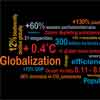
In the run-up to the June 2012 United Nations Conference on Sustainable Development in Rio de Janeiro (Rio+20), it has become increasingly
clear that we need to put "sustainable development" into practice by setting time bound, measurable goals and targets and monitor progress towards achieving them.
Why is this issue important?
Although the term "sustainable development" has existed for decades, it is difficult to assess our progress towards attaining it. At the same
time decision-makers need clear targets and reliable data to track changes. Gross Domestic Product (GDP), the Human Development Index (HDI) and the set of
Millennium Development Goals (MDGs) and related indicators predominantly try to measure its economic and social aspects, and a number of initiatives aim to
track specific aspects of environmental change (i.e. the third pillar of sustainable development). But there is no comprehensive set of goals or targets for
"the future we want" (UN 2012b), nor adequate monitoring of progress towards enduring human and environmental well-being.
Existing goals, targets and indicators for environmental and overall sustainability
Twenty-five years ago, the 1987 World Commission on Environment and Development had already proposed to develop new ways to assess
progress towards sustainable development. This was echoed in subsequent international summits and agreements on sustainable development, including
the first Rio Summit in 1992, the Johannesburg Plan of Implementation in 2002 and the UN Commission on Sustainable Development (CSD). Since
then, other efforts have proposed broad development goals as well as specific targets for environmental improvement.
The Millennium Development Goals (MDGs) is the leading attempt to define specific development goals and targets for developing regions.
Goal 7, oriented to ensuring environmental sustainability (Box 1), is one of the eight global goals and related quantitative indicators to
track progress. A few other international environmental accords include targets, focusing on specific aspects such as climate change and
biodiversity. In addition, UNEP and the Swiss government developed the Global Environment Goals initiative (UNEP 2010) and the fifth
Global Environment Outlook (GEO-5) analyzes gaps in, and progress towards, meeting these (largely qualitative) goals while identifying
policies that can speed up achieving them (UNEP 2012b). Table 1 provides an overview of the relatively few existing numerically-based
environmental goals and targets.
There are a number of interesting initiatives to measure the broader spectrum of sustainable development that include assessments of its
environmental dimensions. All these efforts have their strengths and weaknesses. Table 2 presents an overview of selected composite
indicators and their characteristics.
Currently, however, there is no coherent set of quantified goals, targets and indicators that unfold and measure progress toward
environmental sustainability or sustainable development in general. For any goal or agreement to be effective, it is important to
set out clear numerical targets and the mechanisms to monitor and review them using robust time series data sets. The Montreal Protocol
on Substances that Deplete the Ozone Layer, which includes specific targets and is one of the very few successful international
environmental agreements, clearly demonstrates this.
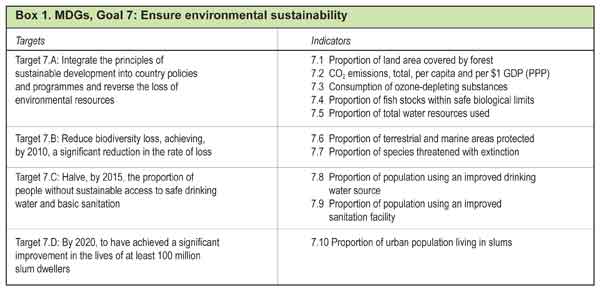
Source: UN 2011a
Full Size Image
In addition to clear goals and targets, solid quantitative indicators showing trends over time are needed to track progress towards stated objectives.
Indicators and composite indices illustrate and communicate complex data and trends in a simplified form and can help shape policy based on transparent information.
While good indicator sets, or aggregated indices, exist on paper, data are often lacking to populate them, especially for developing countries and regions. At the
global level, however, data exist for key indicators to provide an overview of environmental change, available in reports such as "Keeping Track of Our Changing
Environment" (UNEP 2011a) and the UNEP Yearbook (UNEP 2012a).
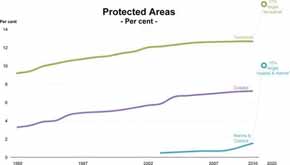
Full Size Image |
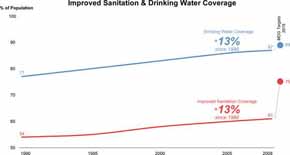
Full Size Image
|
|
Indicator charts from "Keeping Track of Our Changing Environment" to relay the
information about the environmental changes at global level. Source: UNEP 2011a
|
Looking Ahead: Sustainable Development Goals, including Indicators
The Rio+20 Summit offers a new opportunity to address sustainable development issues. The Conference proposes to devise an agreed set of Sustainable
Development Goals (SDGs) and targets, including indicators to monitor progress (UNCSD 2011). In the words of the UN Secretary-General Ban Ki-Moon,
"Let us develop a new generation of sustainable development goals to pick up where the MDGs leave off. Let us agree on the means to achieve them"
(UN 2011b). Inspired by Agenda 21, critical themes and issues that would move the sustainable development agenda forward need to be prioritized,
including the following:
- Combating Poverty
- Changing Consumption Patterns
- Promoting Sustainable Human Settlement Development
- Conserving Biodiversity and Forests
- Protecting the Oceans
- Saving Water Resources
- Advancing Food Security
- Promoting Energy production, including from renewable sources.
Most of these issues are strongly linked to the environment, enabling targets to be firmly rooted in the Earth's biophysical properties.
They should also be geographically scaled because environmental limits differ from the local through to global levels. Nevertheless, it is
ever more evident that the environmental limits to development are at the planetary level and we now urgently need a comprehensive and
solid set of quantified goals, targets and indicators.
Recently, the United Nations Secretary-General's High-level Panel on Global Sustainability (UN 2012c) called for a sustainable development
index or set of indicators to be developed and stipulated that the SDG framework:
- Be universal in character, covering challenges to all countries rather than just developing nations;
- Express a broadly agreed global strategy for sustainable development;
- Incorporate a range of key areas that were not fully covered in the MDGs, such as food security, water, energy, green jobs, decent work
and social inclusion, sustainable consumption and production, sustainable cities, climate change, biodiversity and oceans, as well
as disaster risk reduction and resilience;
- Be comprehensive, reflecting equally the economic, social and environmental dimensions of sustainable development and the interconnections between them;
- Incorporate near-term benchmarks while being long-term in scope, looking ahead to a deadline of perhaps 2030;
- Engage all stakeholders in implementing and mobilizing resources, including local communities, civil society, the private sector and Governments;
- Include progress metrics alongside absolute targets, to focus policy attention as a means of driving development outcomes and to reflect
various development priorities and conditions across countries and regions; and
- Provide scope to review these goals in view of evolving scientific evidence.
Governments will need to agree to develop a set of key universal, sustainable development goals, covering all three sustainable
development pillars and their interconnections. Such goals should galvanize individual and collective action and complement the MDGs, while allowing
for a post-2015 framework. At the same time, public and private entities need to scale up efforts to transparently collect, compile, assess and
disclose relevant data and information to track progress toward such goals.
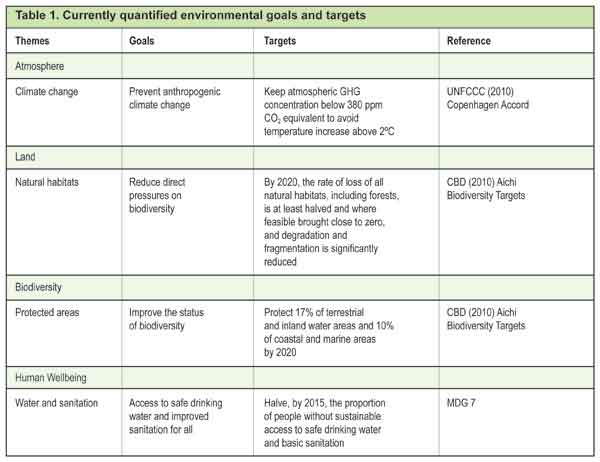
Source: UNEP 2011a, UNEP 2012b
Full Size Image
Various efforts have been made to create aggregate, composite and country-wide indices on environmental trends and sustainable development,
leading to indices such as the Environmental Performance Index, Environmental Sustainability Index, Ecological Footprint, Genuine Savings concept, and
the set of Indicators of Sustainable Development. However, none of them has received the same level of credibility and popularity as UNDP’s Human Development
Index (HDI) (see also Table 2). Underlying methodologies on environmental accounting, such UNSD’s System of Environmental-Economic Accounts (SEEA), are also
being developed and promoted, but implementation is limited and mainly confined to certain developed countries due to its complexity and to data gaps. Generally
speaking, the lack of a clear and simple measurable methodology, such as the ones used for the HDI and the MDGs, coupled with a lack of robust data at country
levels, often hampers the development of credible, world-encompassing composite indices for the environment.

Source: UNEP 2012c
Full Size Image
Acknowledgment:
Written by: Jaap van Woerdena
Production and Outreach Team: Arshia Chanderc, Bruce Pengrac, Erick Litswad, Kim Giesec, Michelle Anthonyc,
Reza Hussainc, Theuri Mwangid
( a UNEP GRID Geneva, b UNEP GRID Sioux Falls, c UNEP Nairobi
References
EC 2011. Beyond GDP: Measuring progress, true wealth, and the
well-being of nations. European Commission, Brussels. http://www.beyond-gdp.eu/ (Accessed on March 20, 2012)
UN 2011a. Millennium Development Goals Indicators. United Nations, New York.
http://mdgs.un.org/unsd/mdg/ (Accessed on March 20, 2012)
UN 2011b. The Secretary General's Report to the General Assembly – "We the Peoples". United Nations, New York.
http://www.un.org/apps/news/infocus/sgspeeches/search_full.asp?statID=1310 (Accessed on March 20, 2012)
UN 2012a. Rio+20 Conference on Sustainable Development. United Nations, New York/Rio de Janeiro.
http://www.uncsd2012.org (Accessed on March 20, 2012)
UN 2012b. The future we want. Zero draft of the outcome document of the United Nations Conference on Sustainable Development – Rio+20.
United Nations, New York. http://www.uncsd2012.org/rio20/content/documents/370The%20Future%20We%20Want%2010Jan%20clean%20_no%20brackets.pdf (Accessed on March 20, 2012)
UN 2012c. Report of the United Nations Secretary-General's High-level Panel on Global Sustainability:
Resilient People, Resilient Planet: A future worth choosing. United Nations, New York. http://www.un.org/gsp/report (Accessed on March 20, 2012)
UNCSD 2011. Current ideas on sustainable development goals and indicators. Rio 2012 Issues Briefs No. 6.
http://www.uncsd2012.org/rio20/index.php?page=view&type=400&nr=218&menu=45 (Accessed on March 20, 2012)
UNEP 2010. Compilation of Internationally Agreed Environmental Goals and Objectives. United Nations Environment Programme, Nairobi.
UNEP 2011a. Keeping track of our changing environment: From Rio to Rio+20 (1992-2012). United Nations Environment Programme, Nairobi.
http://www.unep.org/geo/pdfs/Keeping_Track.pdf (Accessed on March 20, 2012)
UNEP 2011b. Progress towards meeting internationally agreed goals. Findings from GEO-5 Draft 2. United Nations Environment Programme, Nairobi.
http://www.unep.org/pdf/RIO20/progress-internationally-agreed-goals.pdf (Accessed on March 20, 2012)
UNEP 2012a. UNEP Yearbook 2012. United Nations Environment Programme, Nairobi. http://www.unep.org/yearbook/2012/ (Accessed on March 20, 2012)
UNEP 2012b. The fifth Global Environment Outlook (GEO-5). Summary for Policy-Makers (SPM). United Nations Environment Programme, Nairobi.
http://www.uncsd2012.org/rio20/index.php?page=view&type=400&nr=280&menu=45 (Accessed on March 20, 2012)
UNEP 2012c. Status report on composite indices of environmental sustainability. United Nations Environment Programme, Nairobi. (forthcoming)
Information is regularly scanned, screened, filtered, carefully edited, and published for educational purposes. UNEP does not accept any liability
or responsibility for the accuracy, completeness, or any other quality of information and data published or linked to the site. Please read our
privacy policy and
disclaimer for further information.
|











